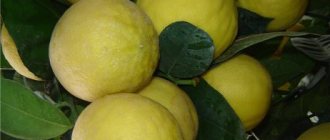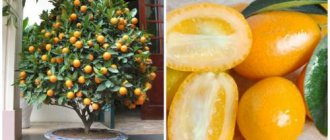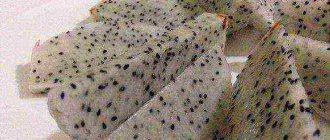Citrus fruits are easily recognized by their rich aroma and bright colors. Thanks to their high content of vitamin C, citrus fruits normalize the body's vital processes and have a strengthening effect on the immune system, promoting appetite and good mood.
Oranges, lemons, tangerines, and grapefruits are always available on store shelves. Many people are not even aware of the many other varieties. There are several dozen types of hybrids that deserve special attention.
Citrus fruits: varieties of oranges and its hybrid varieties
A sweet citrus fruit grown as a result of a natural cross between pomelo and mandarin. Orange is consumed as an independent product and used as an additional ingredient in many culinary dishes. Europeans have adopted another name for the orange – Chinese apple. The popular fruit comes in many varieties, divided into sweet and bittersweet varieties.
Description of orange varieties:
- Citropsis is a traditional African fruit whose second name is African cherry orange. Small fruits with a sweet flavor and cherry-orange skin. Externally, citropsis is very similar to tangerines. Large white seeds are hidden inside the citrus fruit.
- Seville is an orange with bitter veins and a sour, hard aftertaste. The fruits are used exclusively for making sweet desserts - jam, marmalade, juice.
An excellent ingredient for cocktails and marmalades
- Kinglet is an orange with bright pulp and peel. The sweet pulp contains a lot of juice with high vitamin C and no seeds.
The brightest representative
- Wild is an Indian variety of orange. Large fruits with textured skin are used mainly for medicinal purposes.
Hybrid oranges:
- Citrange is a mixture of orange sweetness, which is ideal for sweet dishes, and ponzirus. The round, medium-sized citrus is covered with a smooth, sunny-colored peel.
Solar
- Tankan is a Taiwanese tangerine-orange hybridization. A fruit with a loose, reddish skin. The aromatic tankan has a pleasant taste.
- Orangelo is an exotic orange-grapefruit hybrid. The large orange fruit looks like a grapefruit, but its taste is closer to an orange.
I took the best combination
- Natsudaidai is the result of combining pomelo and a bitter orange variety. A small, elongated fruit with a bright yellow peel that is easy to peel. The sour core is well divided into segments and contains many small seeds.
Interesting color combination
- Murcott is a sweet orange hybrid of orange and tangerine. Round citrus with thin peel and juicy, fragrant pulp.
- Agli are large, weighty fruits obtained by combining orange, grapefruit and tangerine. The ribbed peel is colored light green. Sweet slices contain a lot of juice.
Blend of three citrus fruits
- Kabosu is a hybrid of wild hedgehog and orange. Citrus has smooth green skin and sour flesh. Used in preparing culinary dishes.
- Moroccan citron is a combination of orange bitterness and lemon sourness. Large fruits contain dense pulp with a sweet taste and large seeds.
Use in medicine
The main use of kumquat for treatment comes to us from the recipes of oriental medicine. In China, many dietary supplements are prepared based on essential oil obtained from the peel of the fruit. Tinctures and teas with the addition of kumquat are also useful.
- Whole dried fruits are brewed and made into a healing tea for colds and to improve the functioning of the gastrointestinal tract.
- Dried kumquat peels are infused with alcohol. The drug is drunk for colds, diluted with water or mixed with fresh fruit puree.
- Kumquat tincture with honey is used to cleanse the blood, remove cholesterol plaques from the walls of blood vessels and treat anemia.
- In Chinese medicine, fungal diseases have long been treated by tying dried kumquat to the affected areas of the skin.
- Fresh kumquat juice is drunk to increase concentration; the vitamin C in the composition perfectly tones and adds strength to chronic fatigue syndrome.
- Inhalations based on fresh or dried peels clear the bronchi and lungs of mucus, help with bronchitis, tonsillitis and other diseases of the upper respiratory tract.
In many Chinese homes, housewives place dried kumquat around the house to disinfect the air and eliminate bacteria and viruses.
On a note!
The fruit lightens freckles and age spots. For whiter skin, it is recommended to freeze ice cubes with fresh kumquat juice.
Use in medicine
Citrus fruits: list of popular and hybrid lime varieties
A citrus relative of lemon with a characteristic sour taste. The thin skin of the small round fruits is painted in rich green colors. Compared to lemon, lime pulp is juicier and has a greenish tint.
Popular lime varieties:
- Calamansi is a Philippine citrus with yellow-orange pulp riddled with small seeds.
Fruit from the Philippines
- Kaffir lime is an exotic citrus with a wrinkled, pimply surface. Both the pulp and peel of medium-sized limes are green. Due to its unique appearance, this lime variety is called papeda quillum.
Exotic
- Finger lime is an oval, oblong shaped lime with a thin green peel. The transparent flesh is stratified into individual eggs that are not welded to each other.
Thin slices with eggs
- Limetta is a lime with a sweet flavor. The compressed spherical fruits are yellow with green splashes and have a clearly visible convex papilla.
- Desert limes are small green fruits with a refreshing, tangy flavor. Added to sweet desserts, sauces, drinks.
Hybrid lime varieties:
- Limequat is a hybrid of lime and kumquat. The taste of the pulp has a bitter taste, the peel is green.
Citrus with a bitter aftertaste
- Blood lime is a sweet hybrid of finger lime and tangerine with reddish flesh and skin.
Bloody Citrus
- Papeda is a hybridization of lime and kumquat. The small, bitter fruits are used as garnishes in gourmet dishes.
Used for decoration
- Limandarin is a mixture of lemon, lime and tangerine. Small fruits with smooth yellow skin and red flesh. Despite the high acid content, citrus has a mild flavor. Gives culinary dishes a refined aroma.
- Tahiti lime is the result of crossing lemon, lime and grapefruit. The light green pulp has a lime flavor and hard walls.
What goes with it?
In Russia, many people do not know what kind of fruit it is, what it tastes like, or what dishes prepared with it taste like. In Asian countries, kumquat is not exotic. It is consumed fresh and added to fruit salads, dried and dried, candied and preserved in alcohol, and prepared in desserts and snacks.
Confectioners offer fruit candies, the main ingredient of which is kumquat, completely covered in a chocolate layer. Sweet soufflés, casseroles, confitures, muffins, pies are prepared with it, and alcoholic drinks are also made from it.
We recommend checking out Grapefruit compote
The fruit goes well with meat, fish and vegetable dishes - they are served with a sauce prepared on the basis of Fortunella.
Several recipes will help you evaluate how well exotic fruits combine with different products.
The sauce served with meat, poultry and cheese is prepared based on the following ingredients:
- kumquat - about 300 g;
- water - 180 ml;
- granulated sugar - 150 g;
- cranberries (can use frozen) - 350 g;
- salt - less than half a teaspoon.
The skin of each fruit should be pricked with a fork in 3-4 places. Place the fruits in a saucepan, add water and put on fire. Immediately after boiling, drain the water using a colander. Rinse the fruits under running cold water. Repeat the process of bringing to a boil and rinsing with cold water 2 more times - this will remove the bitterness from the fruit.
Pour the prepared fruits back into the pan, add 180 ml of cold water, and put on high heat. After boiling, reduce the heat and cook the fruit for 15 minutes, remembering to stir.
Remove the fruits from the syrup into a separate container. Add cranberries and salt to the syrup, bring to a boil and simmer for 10 minutes. This time should be enough for the berries to burst.
Cut the cooled kumquat into cubes (remove the seeds first). Place the fruit pieces into the cranberry syrup and stir. Let the sauce cool, remembering to stir it.
You can make a delicious compote from kumquat. It will require 3 ingredients - 200 g of fruit, 80 g of granulated sugar and 1 liter of water. Each fruit is scalded with boiling water and cut into circles. Place the prepared pieces in a saucepan, pour sugar into it and pour out water. Put on the fire, wait until the compote boils, reduce the heat and cook for about 10 minutes.
We recommend that you read Kumquat Recipes
Citrus fruits: list of pomelo varieties
A weighty citrus fruit with a thick, porous skin that is pale green or yellow. The inconspicuous pulp has a slightly sweetish taste. The size of a pomelo can reach several kilograms.
Popular varieties of pomelo:
- Timor is a small pomelo with pale flesh and seeds.
- Siamensis are large citrus fruits with seedless pulp, colored orange and yellow.
- Tong di is a spherical pomelo variety with thin skin and juicy pink flesh.
Delicious pomelo
Hybrid varieties of pomelo:
- Sweetie is a cross between a pomelo and a white grapefruit. The fruits are relatively small and rich green in color.
Honey
- Grosso is a hybrid of lemon and pomelo with a grapefruit-lemon flavor.
Why should you be careful?
Considering the health benefits, these sour fruits help in detoxification and are a rich source of vitamin C and other nutrients that are essential for the human body.
The acidity in citrus fruits is their main feature, as in some cases it can cause stomach upset and difficulty in consumption. Some people develop allergic reactions to these citrus fruits or stomach problems. Therefore, it is necessary to listen to how you feel when using each new product.
Today, most large stores offer many types of citrus fruits. Which ones are the most useful?
Citrus fruits: grapefruit varieties
A large citrus fruit grown by crossing a lemon and an orange. Fragrant citruses weigh up to 500 g and have a spherical shape. The yellow peel of grapefruit has a greenish and orange tint, and in the first case the fruit is considered more juicy and ripe. The pulp of the fruit has a red tint and a pronounced aroma. The taste of grapefruit is sweet and sour with a slight bitterness.
Popular grapefruit varieties:
- Duncan variegata are large spherical fruits with a voluminous peel and juicy, aromatic, sunny-colored pulp.
- Rio Red is a large fruit with a textured skin that is tightly connected to the pulp. Both the outside and the inside of the grapefruit have a pink tint. The pulp is very juicy and pleasant to the taste.
One of the last varieties created
- Jubilee – grapefruit with a thin rind and pleasant taste. In well-ripened fruits, bitterness is practically not felt.
Citrus variety
- Marsh Seedless is a variety of seedless grapefruit. The fruits are medium-sized and yellow in color. The aromatic pulp lacks the classic pink tones of grapefruit.
Large fruit
- Pear-shaped - citrus fruits with ribbed peel and asymmetrical shape. Grapefruits have a pleasant, refreshing taste without pronounced bitterness or sweetness.
Pear-shaped
- Oroblanco is a thick-skinned grapefruit with an even greenish-yellow hue on the outside and a pronounced bitterness on the inside.
Grape
Hybrid varieties of grapefruit:
- Chironha is a hybridization of sweet oranges and tart grapefruits. The slippery yellow skin easily peels off the bright orange pulp.
Large fruit
- Chandler is a hybrid of pomelo and grapefruit. Large fruits are covered with a yellow, smooth skin. The pink-colored slices have a fine-grained structure.
With pink slices
- Melogold - large round citrus fruits obtained by crossing pomelo and grapefruit. The ripe fruit turns mustard-colored. The pulp is juicy and without seeds.
Volumetric fruit
- Hassaku is a bright orange citrus obtained by crossing grapefruit and tangerine. The pale yellow flesh is grainy and dry. Sour grapefruit is eaten with a spoon.
- Citrus Wilson is a cross between papeda and grapefruit. Weighty fruits with voluminous peel and juicy bitter pulp.
Small citrus fruit kumquat
The taste of kumquat is close to tangerine, and the bright orange edible peel has sweet notes, and the fruit pulp contains sourness.
Bright fruit
Popular varieties of kumquat:
- Marumi are large flattened fruits of 4-7 segments with a bright orange thin peel and sour pulp.
- Fukushi are large, bell-shaped fruits with a greenish-yellow color. The pulp has a sweet, spicy flavor.
- Nagami - the fruits have an elongated shape and do not contain seeds.
- Malayan kumquat - large oblong fruits of bright orange color with seeds inside.
Elongated fruits
Hybrid varieties of kumquat:
- Sunquat is a cross between lemon and kumquat. The fruits are of uneven size with sourish pulp and zest.
- Meiva is a sweet, round-shaped kumquat with tasty seedless pulp.
- Mandarinquat is a hybridization of kumquat and grapefruit. Citrus is shaped like a light bulb and has a carrot color. Pulp with a tart unique taste.
Fruit shaped like a light bulb
- Thomasville - tiny kumquat and citrange fruits with the shape of a light bulb, thin skin and a bitter aftertaste.
We advise you to read interesting articles with useful lists:
- Nuclear powers of the world for 2021
- Shade-tolerant flowers for the garden, summer flowers
- The most dangerous foods
- List of positive, negative, neutral human emotions
- The best drugs for migraines - list











